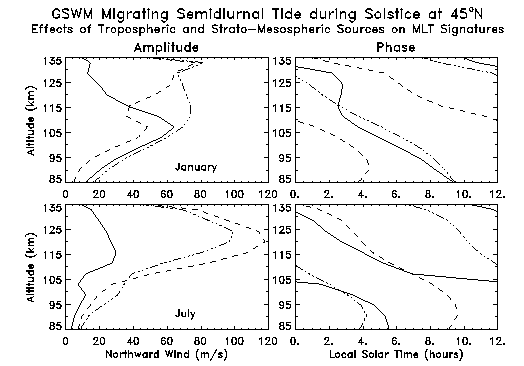

Peak amplitudes occur above 100 km in the lower thermosphere at approximately +/-50 degrees latitude (zonal and meridional) and +/-40 degrees for the temperature and vertical velocity fields, which also have strong peaks over the equator. The meridional and zonal wind fields also have a secondary set of maxima with respect to latitude, over the equatorial regions.
There is a shift of these peaks in latitude toward the winter pole during solstice, and a slight lowering of the altitude at which the most winter-poleward peak occurs. Equinox peaks are more than 100% higher than solstice peaks.
There are two maxima and two minima (two cycles) of this wave per day (i.e. with respect to longitude), as opposed to the single set of maxima and minima in the diurnal wave. However, its vertical wavelength is much longer at 48-58 km than that of the diurnal tide, which is 20-25 km. The higher frequency and longer wavelength give the wave a higher phase speed, which is why gravity wave interactions do not diminish the amplitude of the semidiurnal tide like they do the diurnal tide.
As shown in the figure, the tidal response to the main thermal driving forces, UV (dashed) and IR (dashed-dot-dashed) heating, are of similar amplitude but varying phase, depending on season and altitude. The resulting overall response to the thermal heating varies with location and month. This changes the latitudinal, and to a lesser extent, altitudinal structure of the semidiurnal perturbation, with season.

Graphical output from the GSWM illustrates the characteristics of the semidiurnal waves.